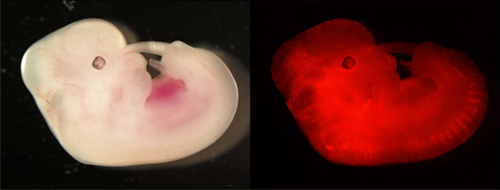| RIKEN Center for Developmental Biology (CDB) 2-2-3 Minatojima minamimachi, Chuo-ku, Kobe 650-0047, Japan |
“A number of recent studies have greatly improved our understanding of the transcriptional network that maintains pluripotency and as a result the model had been getting simpler and simpler,” says Masui. “But one of the most important pieces, Sox2, still hadn’t been fit into place. Now that we have worked out its precise function, for better or worse, the model has gotten a bit more complicated again. " Previous studies had shown that the silencing of Sox2 by RNA interference in ES cells resulted in their differentiation into multiple lineages and that most pluripotency associated genes contain Oct and Sox binding motifs, which pointed strongly, but not conclusively, to the possibility that these two transcription factors were regulated by a positive feedback loop. After confirming that Sox2-deficient cells do indeed differentiate (into trophectoderm-like cells; an effect similar to that caused by loss of Oct3/4 function), they looked at enhancer activity by comparing cells transfected with Oct-Sox enhancer constructs carrying mutations in their Sox binding sites. Unexpectedly, there was little effect on enhancer activity, opening up the possibility that Sox2 might function redundantly in cooperation with other Sox factors, meaning that its loss could be compensated for by the activity of one or more related genes. This, however, left the team with the puzzle of why Sox2 null mutant ES cells would fail to maintain their pluripotency and differentiate into trophectoderm. One interesting observation was the number of genes whose expression changed over time in response Sox2 loss-of-function, particularly the upregulation of genes known either to downregulate Oct3/4 or to cause ES cells to undergo differentiation. This pattern suggested that rather than influencing the activity of the Oct-Sox enhancers, Sox2 might instead be promoting the expression of positive regulators Oct3/4, while repressing its inhibitors and inducers of differentiation. Masui devised a strategy for studying this question by introducing an Oct3/4 transgene into ES cells with a conditional Sox2 deletion. On inhibiting Sox2, levels of endogenous Oct3/4 dropped precipitously, but the transgene remained unaffected and, tellingly, the ES cells remained pluripotent, as evidenced by their ability to contribute to all three germ layers in chimeric embryos. This work, which has been published in the online edition of the journal Nature Cell Biology, stands as a significant revision of the conventional wisdom regarding the Oct-Sox interaction, making a strong case for the unique function of Sox2 in the maintenance of pluripotency via its regulation of the regulators of Oct3/4. “The molecular events governing pluripotency remain mysterious, even though the factors to establish pluripotency have been identified and in silico analyses have been used to attempt to develop a simplified model for the transcription factor network,” says Niwa, “but I think the only way to solve this puzzle will be to keep chipping away at the molecular functions one by one.” |
|||||
|
|||||
 |
| Copyright (C) CENTER FOR DEVELOPMENTAL BIOLOGY All rights reserved. |
